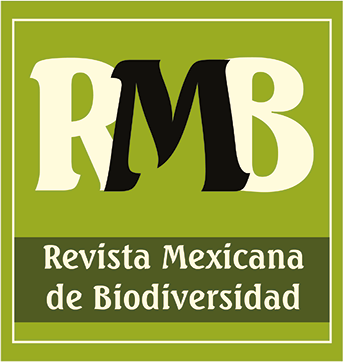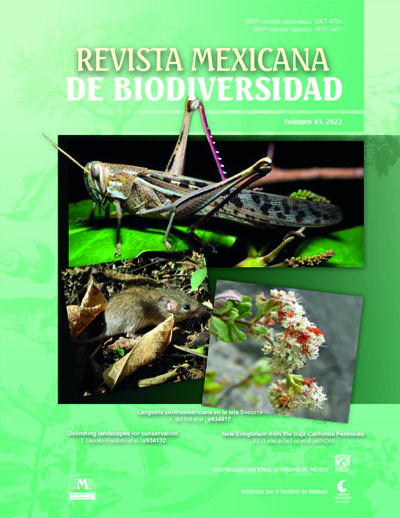Morphological variability and ecological distribution of species of the genus Aulacoseira (Bacillariophyceae) present in bodies of water in central Mexico
DOI:
https://doi.org/10.22201/ib.20078706e.2022.93.4197Keywords:
Central diatoms, Morphology, Environmental parameters, Ecology, Lake basinsAbstract
Relative abundance and morphological variability of 4 species and 1 variety of the genus Aulacoseira (Bacillariophyceae) were analyzed in sediments from lakes with different climatic, morphometric, physicochemical and tropic level regimes. Canonical correspondence analysis and weighted average optima were used to identify the ecological preferences of each taxon. The results show that temperature, salinity and trophic level were the main environmental variables defining species distribution. The species of the genus Aulacoseira were present only in circumneutral-slightly alkaline localities with low salinity. Aulacoseira granulata was the most frequent taxon and had
the higher salinity tolerance, A. ambigua reached the highest relative abundances, A. nivaloides stand out because of
its affinity for cold waters, of very low salinity and trophic level. Aulacoseira ambigua, A. granulate, and A. granulata var. angustissima prefered freshwater, meso-eutrophic conditions and A. pusilla turbid waters with high phosphorus
concentrations. This study provides information on the biological variability and distribution of the species within the
genus in lakes from central Mexico.
References
Avendaño, D., Caballero, M. y Vázquez, G. (2021). Ecological distribution of Stephanodiscus niagarae Ehrenberg in central Mexico and niche modeling for its last glacial maximum habitat suitability in the Nearctic realm. Journal of Paleolimnology, 66, 1-14. https://doi.org/10.1007/s10933-021-00178-w
Bicudo, D., Tremarin, P., Almeida, P., Zorzal-Almeida, S., Wengrat, S., Faustino, S. et al. (2016). Ecology and distribution of Aulacoseira species (Bacillariophyta) in tropical reservoirs from Brazil. Diatom Research, 31, 199–215. https://doi.org/10.1080/0269249X.2016.1227376
Buczkó, K., Magyari, E. y Ognjanova-Rumenova, N. (2010). Taxonomy, morphology and distribution of some Aulacoseira taxa in glacial lakes in the South Carpathian Region. Polish Botanical Journal, 55, 149-163.
Caballero, M. (1995). Late Quaternary paleolimnology of Lake Chalco, the Basin of Mexico (Tesis doctoral). Inglaterra, University of Hull.
Caballero, M. y Sigala, I. (2017). Datos hidrogeoquímicos. Base de datos. Instituto de Geofísica, UNAM. Ciudad de México. https://datosabiertos.unam.mx [consultado 27 septiembre 2021].
Caballero, M., Lozano-García, S., Ortega-Guerrero, B. y Correa-Metrio, A. (2019). Quantitative estimates of orbital and millennial scale climatic variability in central Mexico during the last∼40,000 years. Quaternary Science Reviews, 205, 62–75. https://doi.org/10.1016/j.quascirev.2018.12.002
Cho, K. J. (1999). Morphology and taxonomy on Diatom Genus Aulacoseira in the Naktong River. Algae, 14, 143–153.
Crawford, R. y Likhoshway, Y. (1999). The frustule structure of original material of Aulacoseira distans (Ehrenberg) Simonsen. Diatom Research, 14, 239-250. https://doi.org/10.1080/0269249X.1999.9705468
Cuna, E., Zawisza, E., Caballero, M., Ruíz-Fernández, C. y Lozano-García, S. (2014). Environmental impacts of Little Ice Age cooling in central México recorded in the sediments of a tropical alpine lake. Journal of Paleolimnology, 51, 1–4. https://doi.org/10.1007/s10933-013-9748-0
Denys, L., Muylaert, K., Krammer, K., Joosten, T., Reid, M. y Rioual, P. (2003). Aulacoseira subborealis stat. nov. (Bacillariophyceae): a common but neglected plankton diatom. Nova Hedwigia, 77, 407–427. https://doi.org/10.1127/0029-5035/2003/0077-0407
Dunck, B., De Souza, I. y Machado, M. (2012). Planktonic diatoms in lotic and lentic environments in the Lago dos Tigres hydrologic system (Britânia, Goiás, Brazil): Coscinodiscophyceae and Fragilariophyceae. Brazilian Journal of Botany, 35, 181–193. https://doi.org/10.1590/S0100-84042012000200007
English, J. y Potapova, M. (2009). Aulacoseira pardata sp. nov., A. nivalis comb. nov., N. nivaloides comb. et stat. nov., and their occurrences in western North America. Proceedings of the Academy of Natural Sciences of Philadelphia, 158, 37–48.
Fritz, S. (2007). Salinity and climate reconstruction from diatoms in continental lake deposits. En S. A. Elias (Ed.), Encyclopedia of Quaternary Science (pp. 514–522). Amsterdam: Elsevier.
Gasse, F., Juggins, S. y Khelifa, L. B. (1995). Diatom-based transfer functions for inferring past hydrochemical characteristics of African lakes. Palaeogeography, Palaeoclimatology, Palaeoecology, 117, 31–54.
Gómez, N. y Bauer, D. (2000). Diversidad fitoplanctónica en la franja costera sur del Río de la Plata. Biología Acuática, 19, 7–26.
Gómez, N., Riera, J. y Sabater, S. (1995). Ecology and morphological variability of Aulacoseira granulata (Bacillariophyceae) in Spanish reservoirs. Journal of Plankton Research, 17, 1–16. https://doi.org/10.1093/plankt/17.1.1
Guiry, M. y Guiry, G. (2021). AlgaeBase. World-wide electronic publication, National University of Ireland, Galway Base de datos https://www.algabase.org [consultado 3 feb 2021].
Gusev, E. y Kulikovski, M. (2014). Centric diatoms from Vietnam reservoirs with description of one new Urosolenia species. Nova Hedwigia, Beiheft, 143, 111–126.
https://doi.org/10.1127/1438-9134/2014/006
Joh, G. (2010). Algal Flora of Korea. Vol. 3. Number 1. Chrysophyta: Bacillariophyceae: Centrales. Freshwater Diatoms I. Incheon, South Korea: National Institute of Biological Resources. Ministry of Environment.
Kilham, P., Kilham, S. S. y Hecky, R. E. (1986). Hypothesized resource relationships among African planktonic diatoms. Limnology and Oceanography, 31, 1169–1181.
Kociolek, P., Theriot, E., Williams, D. Julius, M., Stoermer, E. y Kingston J. (2014). Chapter 15. Centric and Araphid diatoms. En J. Wehr, R. Sheath y J. Kociolek (Eds.), Freshwater Algae of North America. Ecology and Classification. 2ª ed. Cambridge, MS: Academic Press. https://doi.org/10.1016/B978-0-12-385876-4.00015-3
Kolbe, R. W. (1927). Zur ökologie, morphologie und systematik der brackwasser-diatomeen: Die kieselalgen des Sperenberger salzgebiets: Jena Fischer.
Krammer, K. y Lange-Bertalot, H. (1991). Süwasserflora von Mittleleuropa. Vol. 2/3 Bacillariophyceae: Centrales, Fragilariaceae, Eunotiaceae. Gustav Fischer Verlag.
Lange-Bertalot, H. (2001). Diatoms of Europe. Diatoms of the European inland waters and comparable habitats. Berlin: Ganter Verlag.
Lee, K. y Yoon, S. (1994). Morphologic Accounts on the Diatom Genus Aulacoseira, the Dominant of the Han River. Algae, 9, 135–143
Maidana, N. y Díaz, V. (2001). Diatomeas de lagos oligotróficos andinos (Provincia de Neuquén, Argentina). Boletín de la Sociedad Argentina de Botánica, 36, 15–27.
Novelo, E. y Tavera, R. (2021). bdLACET Base de datos de algas continentales. Facultad de Ciencias, UNAM. México [consultado 11 junio 2021]. Disponible en https://bdlacet.mx
Oksanen, J., Blanchet, G., Friendly, M., Kindt, R., Legendre, P., McGlinn, D. et al. (2020). Community Ecology Package “Vegan” [online]. Paquete de R versión 2.5-7. Disponible en: https://cran.r-project.org/web/packages/vegan/vegan.pdf
Organization for Economic Cooperation and Development (OECD). (1982). Eutrophication of waters. Monitoring, assessment and control. Paris: Organization for Economic Cooperation and Development.
Pereira, K., Tremarin, P. I. y Veiga, T. A. (2013). Taxonomic studies of centric diatoms (Diatomeae): unusual nanoplanktonic forms and new records for Brazil. Acta Botanica Brasilica, 27, 237–251.
Potapova, M. (2010). Aulacoseira pusilla. En Diatoms of North America, Base de datos https://diatoms.org/species/aulacoseira_pusilla. [Consultado 27 septiembre 2021].
Potapova, M., Bixby, R., Charles, D., Edlund, M., Enache, M., Furey, P. et al. (2008). Representatives of the genus Aulacoseira Thwaites in NAWQA simples. Eighteenth NAWQA Workshop on Harmonization of Algal Taxonomy April 27-29, 2007. Report No. 08-07. The Academy of Natural Sciences of Philadelphia.
Potapova, M. y English, J. (2010). Aulacoseira granulata. Diatoms of North America, Base de datos https://diatoms.org/species/aulacoseira_pusilla. [Consultado 27 septiembre 2021].
Round, F. E., Crawford, R. M. y Mann, D. G. (1990). The diatoms. Biology y morphology of the genera. Cambridge: Cambridge University Press.
Rumrich, U., Lange-Bertalot, H. y Rumrich, M. (2000). Diatoms of the Andes. Berlín: A.R.G Gantner Verlang K.G.
Sathicq, M., Nicolosi-Gelis, M. y Cochero, J. (2020). Calculating autoecological data (optima and tolerance range) for multiple species with the ‘optimos. prime’ R package. Austral Ecology, 45, 845–850. https://doi.org/10.1111/aec.12868.
Sigala, I., Caballero, M., Correa-Metrio, A., Lozano-García, S., Vázquez, G., Pérez, L. et al. (2017). Basic limnology of 30 continental waterbodies of the Transmexican Volcanic Belt across climatic and environmental gradients. Boletín de la Sociedad Geológica Mexicana, 69, 310–370. https://doi.org/10.18268/BSGM2017v69n2a3
Siver, P. y Kling, H. (1997). Morphological observations of Aulacoseira using scanning electron microscopy. Canadian Journal of Botany, 75, 1807–1835. https://doi.org/10.1139/b97-894
Tucci, A., Orth, L., Segecin, R. y Bicudo, C. (2006). Criptogamos do Parque Estadual das Fontes do Ipiranga, Sao Paulo, SP. Algas, 20: Coscinodiscophyceae. Hoehnea, 33, 115–122.
Tuji, A. (2015). Distribution and Taxonomy of the Aulacoseira distans Species Complex Found in Japanese Harmonic Artificial Reservoirs. Bulletin of the National Museum of Nature and Science. Series B, Botany, 41, 53–60.
Tuji, A. y Williams, D. (2006). Type examination of the freshwater centric diatom Aulacoseira pusilla (F. Meister) Tuji et Houki. Diatom, 22, 70–73.
Tukia, J. y Lepistö, L. (1999). Sizes variations of planktonic Aulacoseira Thwaites (Diatomeae) in water and in sediment from Finnish lakes of varying trophic state. Journal of Plankton Research, 21, 757–770.
Vázquez, G. y Caballero, M. (2013). The structure and species composition of the diatom communities in tropical volcanic lakes of eastern Mexico. Diatom Research, 28, 77–91.




